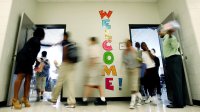Strategies That Help Students Manage Transitions
When students find moving from one activity to another challenging, these simple activities can help them self-regulate.
Your content has been saved!
Go to My Saved Content.Teachers often come to me with difficulties their students have when transitioning from one activity to another and one class to another, both on an individual basis and across entire classrooms. Students can struggle with this skill due to challenges with sensory processing, such as emotional regulation, attention, and speech and language processing. Difficulties with transitioning may manifest in a variety of different behaviors, including avoidance, decreased attention, resistance, or fight-or-flight.
I have found the strategies below to be helpful in my clinical occupational therapy practice, both in a one-to-one setting and on a whole-class basis.
Each of these strategies can be completed both before transitions and as a class is transitioning—at either point they can help students stay regulated. You may want to make a list or visual of these supports (e.g., images of students performing these exercises or strategies), and pin it on the wall next to the classroom doorway or print it out and distribute it to students as a reminder.
Before your students begin a transition after a class with high levels of physical stimulation, consider having them take a collective deep breath. Also, if you have particular students who exhibit extreme difficulty with transitions, consider naming them “transition leaders” and have them lead the class in each strategy. Providing them with this leadership role may minimize dysregulation by providing ownership and a sense of increased responsibility, control, and confidence.
Transition Strategies
Hands on hips: Have your students stand with their feet firmly planted and then place their palms on their hips. Have them keep this position when walking. Pressing down on joints provides the body with information about where it is in space (called proprioceptive input); pressure on the hips gives students awareness of a central point of balance and control within their bodies, which can decrease the fight-or-flight response, thus increasing overall regulation.
Tell me a story: Ask your students to visualize a story unfolding and share it with a friend or a helpful adult, or have your students tell a collective story in which each contributes one sentence. Try asking students who struggle significantly with transitions to choose a story (ideally one that features transitions) to tell their peers when moving from one task to another—e.g., “Once upon a time there was a puppy. The puppy loved to visit the park after school every day...”
I’ve found that storytelling can distract students if they are feeling emotionally or physically dysregulated, and it can be particularly powerful when it solidifies part of a transition routine; children who have difficulty with transitions often benefit from routine, structure, and predictability.
Fidgets and weighted fanny packs: Fidgets are sometimes mentioned with respect to metacognitive “strategy instruction,” as tools that help students reflect on their thinking, self-monitor, and take ownership of their learning. I’ve found that the act of fidgeting (not necessarily the fidget itself) can help students with their attention and retention.
Any number of sensory items can double as fidgets, such as wax craft sticks, putty, or weighted beanbags. Once a student has found sensory tools that work for them, tell them to try placing the sensory items in a fanny pack or small bag in the morning. The weight and pressure on their torso can help them feel calm and safe because it signals where their body is in space. Some students benefit from options, so try having them put several fidgets on a textured keychain or have them bundle the fidgets with Velcro.
MP3 players and low-frequency music: If you have a student who struggles significantly with transitions, consider providing them with an MP3 player paired with low-frequency music, which can aid in improving regulation. For example, drums provide low-bass sounds that assist in organizing and timing our bodies; the flute provides sounds that can improve attention to presented tasks; guitar, cello, and rain instruments are reported to be calming; and piano can help with organization.
The number of beats per minute is important in terms of focus: 100 beats per minute is reported to be best in aiding attention to presented tasks, while 60 beats per minute is said to be best before bed, as it helps to return the body to its natural rhythm.
Walk and squeeze: This exercise is an effective means to functional regulation skills. Have your students do this routine as a variation on Mountain Pose. Direct them to rest their hands on their hips. Tell them that when you say “Freeze,” they should freeze as if they are making their entire body into one muscle; once they hear you say “Relax,” they should release the muscle and place their hands back on their hips.
Arm moves: This strategy targets mirror neurons of the brain and relates to the sensory processing of the actions of others and consequent motor planning, making it a good exercise for your students to use before walking through the school or before a difficult activity. Utilizing the wall adds additional tactile input, improving the child’s ability to follow along and perform the exercises correctly while improving self-regulation through calming touch input. Arm moves work even better when you do them with your students so that you’re moving your arms in sync.
Tell your students something to this effect: “Follow me as I move my arms. Place your arms against the wall and keep your eyes on me as you move your arms slowly. Follow my movements. Pretend that you are my mirror—your movements should copy mine exactly.”
